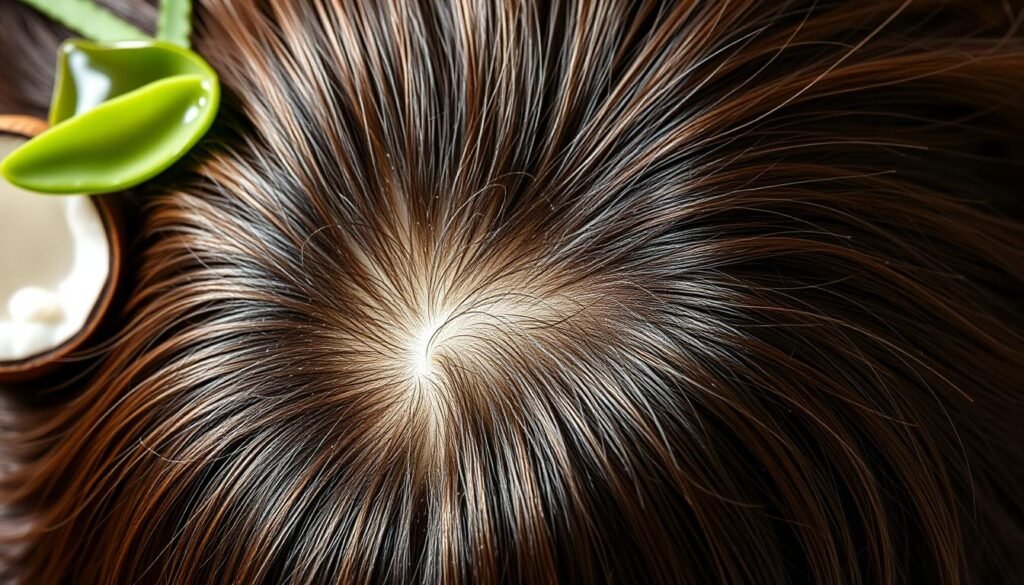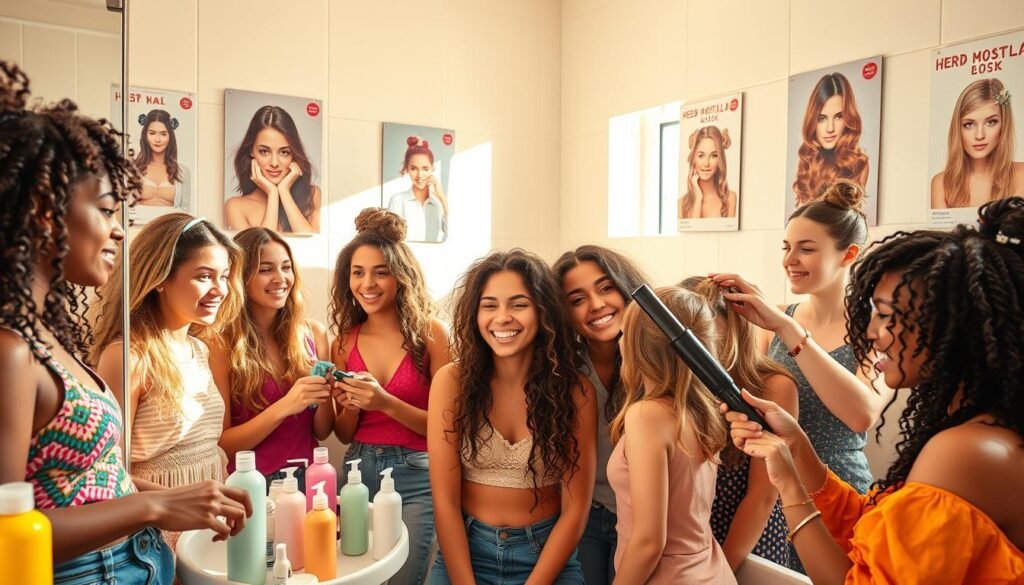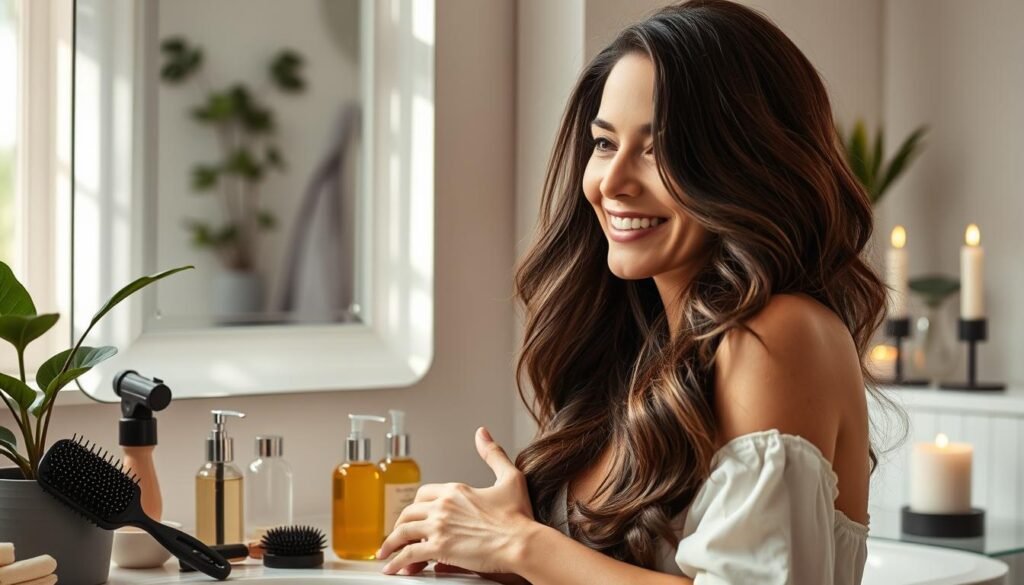Affiliate Disclosure: This post contains Amazon affiliate links. When you buy a product using the links below, we get commissions, but it doesn’t cost you anything extra. We thank you in advance for purchasing a product using the given links!
Welcome to your ultimate guide to hair care tips for every stage of life. As you age, your hair’s needs change due to age, hormonal shifts, and lifestyle. Understanding these changes is vital for healthy hair.
This detailed article shares practical hair maintenance tips for each life stage. This guide is your roadmap from your teenage years to your senior years. It’s designed for anyone looking to improve their haircare routines. Remember, you can always enhance your hair health, regardless of age!
Key Takeaways
- Hair needs to evolve with age and lifestyle changes.
- Establishing a solid haircare routine early on promotes long-term health.
- Understand the impact of hormonal changes on hair quality.
- Embrace the unique challenges at each life stage.
- Specific products can enhance hair health as you age.
Understanding Your Hair’s Needs Throughout Life

Every stage of life introduces distinct hair changes with age. From the soft, luscious locks of childhood to the more brittle strands of maturity, grasping these transformations is key for maintaining healthy hair. Hormonal shifts during puberty or menopause can unexpectedly alter hair texture and volume, presenting challenges and opportunities for care.
Nutrition is vital throughout these changes. Protein-rich foods support hair growth, while vitamins like Biotin and Vitamin D nourish your scalp. Hydration is also crucial; water is the unsung hero of beautiful hair. Environmental factors such as pollution or UV rays can accelerate aging and require additional protective measures in your hair care routine.
Awareness of how hair changes with age helps individuals tailor their hair care strategies. Frequent hair treatments, gentle shampoos, and regular trimming enhance hair vitality, making adjustments more straightforward. By adopting effective practices tailored to unique needs, individuals can nurture their tresses through different life stages.
| Life Stage | Characteristics | Care Tips |
|---|---|---|
| Childhood | Smooth, fine hair | Use gentle shampoos; avoid excessive heat |
| Teenage Years | Increased oiliness, texture changes | Balance cleansing and conditioning |
| Twenties | Fullness and vitality | Establish a healthy routine; minimize damage |
| Thirties | Possible thinning | Focus on nourishing products |
| Forties and Beyond | Texture changes; increased dryness | Opt for hydrating treatments; consider professional care |
The Basics of Healthy Hair Care

Understanding your hair’s unique needs is the first step to healthy hair. Knowing your hair type is crucial for effective hair care. The right products are essential whether your hair is straight, wavy, or curly. Choose high-quality shampoos and conditioners that match your hair type—for example, dry hair benefits from moisturizing products, while oily hair needs volumizing.
Regular trims are essential for maintaining healthy hair. Visit your stylist every six to eight weeks to prevent split ends. This keeps your hair looking polished and supports healthy scalp care by preventing breakage.
Hydration is a critical hair maintenance tip. Deep conditioning treatments boost moisture levels, protecting against environmental damage. Avoid excessive heat styling to preserve your hair’s health. If you must use heat tools, always use a heat protectant to minimize damage.
Healthy hair requires combining the right products, regular trims, and protective measures. Prioritize these best hair care practices for lasting beauty and health.
| Hair Type | Recommended Shampoo | Conditioner Type | Trimming Frequency |
|---|---|---|---|
| Straight | Sulfate-free | Lightweight | Every 8-12 weeks |
| Wavy | Moisturizing | Hydrating | Every 6-8 weeks |
| Curly | Co-Wash | Thick Creamy | Every 8-10 weeks |
| Coily | Oil-infused | Deep Conditioner | Every 10-12 weeks |
Hair Care Tips for Every Stage of Life

Understanding the phases of hair care is crucial for maintaining luscious locks at any age. The teenage years bring significant changes, while the twenties offer a chance to establish solid routines. Here’s how to navigate these distinct stages with effective strategies.
Teenage Years: Embracing Change
The teenage years can feel like a whirlwind for hair, with puberty often leading to oily scalps and breakage from aggressive styling. These changes can challenge managing hair health in teens. Incorporating teenage hair care tips is essential for fostering healthy habits. Consider these strategies:
- Choose gentle, sulphate-free shampoos to avoid stripping natural oils.
- Limit heat styling by opting for air-drying techniques.
- Embrace a leave-in conditioner to combat frizz and nourish strands.
Twenties: Establishing a Routine
As one transitions into their twenties, hair care in their 20s becomes a priority. This vibrant phase is ideal for creating a consistent regimen. Regular deep conditioning treatments can repair damage and maintain moisture levels. Protecting against heat styling damage is also critical. Here are five effective tips for healthy hair:
- Incorporate a weekly hair mask to restore vitality.
- Use thermal protectant sprays before using heat tools.
- Schedule regular trims to prevent split ends.
- Opt for hairstyles that minimize stress on the hair shaft.
- Hydrate from within by drinking plenty of water.
Establishing effective hair care routines during this stage will lay the foundation for future hair health.
Hair Care in Your 30s: Maintaining Luster

As you enter your 30s, your hair may need more attention. Environmental stressors, lifestyle choices, and hormonal changes can cause wear and tear. It’s crucial to focus on maintaining healthy hair during this decade. Choosing the right products is vital to keeping your hair looking vibrant. Here are some tips to help you achieve that.
Effective Products for Healthy Hair
Choosing the proper hair care products is vital. Opt for sulphate-free shampoos, as they are gentler and preserve moisture. Pureology Hydrate Shampoo and SheaMoisture Raw Shea Butter Moisture Retention Shampoo are excellent choices for your 30s. Adding nourishing oils to your routine can also revitalize your hair. Moroccanoil Treatment and Olaplex No. 7 Bonding Oil are great for adding shine. Tailor your routine to your hair type to support its health.
Dealing with Thinning Hair
Thinning hair is typical in your 30s. It can be challenging, but there are ways to manage it. Eating a protein-rich diet, vitamins, and minerals can strengthen your hair. Supplements like biotin and omega-3 fatty acids also support hair health. For quick results, consider products like Rogaine and BIOLAGE R.A.W. Replenishing Shampoo, specifically designed for hair loss.
| Product Type | Recommended Products | Benefits |
|---|---|---|
| Shampoo | Pureology Hydrate Shampoo | Sulfate-free, hydrates while cleansing |
| Shampoo | SheaMoisture Raw Shea Butter Moisture Retention Shampoo | Moisturizes and nourishes dry hair |
| Oils | Moroccanoil Treatment | Restores shine and smoothness |
| Oils | Olaplex No. 7 Bonding Oil | Strengthens and protects from heat damage |
| Products for Hair Loss | Rogaine | Stimulates hair growth, works on thinning areas |
| Products for Hair Loss | BIOLAGE R.A.W. Replenishing Shampoo | Gentle formula promotes healthy hair growth |
Hair Care in Your 40s: Combatting Signs of Aging

Reaching your 40s is a significant milestone, but it often brings changes to your hair. You might notice dryness, brittleness, and the emergence of gray strands. It’s crucial to understand how to manage these changes for healthy hair. Effective hair care in your 40s requires specific strategies tailored for this life stage.
One effective tactic is incorporating hydrating masks into your routine. These products help restore moisture, combating the dryness of aging. Regular use can revive your hair’s natural shine and keep it looking vibrant.
Colouring techniques also play a vital role. Precision colouring offers a modern way to embrace and blend grays without harsh contrasts. Opting for high-quality dyes like those from L’Oréal or Clairol can give you that youthful shine while maintaining a polished look.
The scalp also needs attention. A simple yet often overlooked method is regular scalp massages. This practice boosts circulation, promotes healthier hair follicles, and revitalizes hair growth. During your massage, nourishing oils, such as argan or jojoba oil, can offer additional benefits.
In summary, implementing these aging hair care tips addresses aging signs and transforms your hair into a striking feature. Here’s a quick summary:
| Tip | Description |
|---|---|
| Hydrating Masks | Replenish moisture to combat dryness. |
| Precision Coloring | Blend grays seamlessly with high-quality dyes. |
| Scalp Massages | Boost circulation and encourage healthy hair growth. |
These methods reflect a shift in your hair care strategy as you navigate your 40s. Embrace these changes to keep your hair healthy and vibrant.
Hair Care for Seniors: Embracing Silver Strands
As we age, our hair undergoes significant changes. Embracing those silver strands can be beautiful, but caring for elderly hair requires special attention. Transitioning to a silver look symbolizes wisdom and presents a unique opportunity to experiment with softer shades. Here are some essential tips for maintaining smooth, manageable hair that will have you shining like a silver coin!
Essential Tips for Soft, Manageable Hair
Caring for elderly hair entails embracing products that cater to the needs of mature strands. The focus should be on hydration, nourishment, and gentleness. Here are some effective strategies to maintain your mane:
- Use sulfate-free shampoos. Sulfates can strip natural oils, leading to dryness. Look for soft silver hair products designed specifically for mature hair that keep locks hydrated.
- Deep conditioning treatments: Regular use of deep conditioners helps combat the brittleness often accompanying aging hair. Seek out formulas rich in natural oils.
- Scalp care: A healthy scalp supports stronger hair. Gentle massage during shampooing can improve circulation, fostering better hair growth.
- Minimize heat styling: Hot styling tools can aggravate dryness. Embrace natural styles or use a lower heat setting when necessary.
- Regular trims: Keeping your hair trimmed prevents split ends, promoting healthier growth and a polished appearance.
To further enhance your hair care routine, consider the following comparison of various soft silver hair products:
| Product | Key Ingredients | Benefits |
|---|---|---|
| Kevin Murphy Angel Wash | Natural oils, antioxidants | Hydrates and adds shine without heaviness |
| Conditions detangle and boost shine | Argan oil | Conditions detangle, and boost shine |
| Aussie 3-Minute Miracle Moist | Australian jojoba oil | Repairs and softens for manageable hair |
| Bumble and Bumble BB Hairdresser’s Invisible Oil | Six lightweight oils | Softens and smooths, combats frizz |
Incorporating these soft silver hair products and tips into your hair care routine for seniors can transform the way you feel about your locks. Treat your hair with the love and care it deserves, and watch those silver strands dazzle!
Hair Care During Pregnancy: Nourishing Your Locks
Pregnancy brings about numerous changes; one of the most noticeable might be your hair. Expectant mothers often experience changes like increased thickness or a bit of oiliness. This can lead to a more luxurious mane, but maintaining healthy pregnancy hair requires attention and care.
Garnishing your locks becomes essential during pregnancy as your body undergoes hormonal shifts. Consider incorporating essential vitamins, such as folic acid and biotin, into your diet. These nutrients support strong hair growth and overall scalp health.
Choosing the right products is equally essential for effective hair care during pregnancy. Opt for gentle, chemical-free shampoos and conditioners that are kind to your hair and safe for your growing baby. Avoiding potentially harmful ingredients helps ensure your hair remains vibrant and healthy without compromising safety.
- Regularly deep condition to maintain moisture and manageability.
- Limit heat styling to prevent damage.
- Experiment with protective hairstyles to safeguard your strands.
Incorporating these practices will help you embrace the beauty of your changing hair while supporting a healthy pregnancy. Enjoy the journey, and let your hair shine as brightly as the new life you are nurturing!
Hair Care During Menopause: Adapting to Changes
The onset of menopause can be like a roller coaster ride, especially for hair care. Hormonal changes often cause thinning, dryness, and texture shifts. It’s crucial to accept these changes when managing menopausal hair.
Hydration is crucial to hair health. Invest in moisturizing shampoos and conditioners. Look for products with argan oil, shea butter, or coconut oil. These ingredients add moisture and prevent breakage.
High-quality hair products are just the start. Making lifestyle changes can also help a lot. A balanced diet rich in vitamins and minerals is vital for hair health. Salmon, nuts, and leafy greens provide essential nutrients for more robust, shinier hair.
Here is a table highlighting some effective strategies for managing menopausal hair:
| Strategy | Description |
|---|---|
| Hydrating Products | Utilizing shampoos and conditioners with hydrating ingredients to combat dryness. |
| Regular Trims | Getting regular haircuts helps remove split ends and maintain a fresh look. |
| Scalp Care | Massaging the scalp stimulates circulation and promotes healthy hair growth. |
| Balanced Diet | Incorporating foods rich in Omega-3 fatty acids and antioxidants for overall hair health. |
| Stress Management | Practicing mindfulness and relaxation techniques can improve hair health indirectly. |
Adapting to these changes empowers you to keep your hair beautiful during this phase. With proper hair care and a mindset, menopausal hair management becomes more manageable.
Conclusion
Our hair undergoes a remarkable transformation influenced by age, health, and hormonal changes. Understanding these shifts is critical for practical hair health tips. Tailoring hair care to each life stage ensures your hair stays vibrant and healthy. Remember, what worked in your teens may not cut it in your forties!
Adapting your hair care regimen is crucial as you move from youth to maturity. Each life phase brings unique challenges and opportunities for your hair. Whether facing thinning strands in your thirties or embracing silver hues in your sixties, informed choices lead to healthier hair.
Embrace your hair journey! Arm yourself with knowledge and nourishing products. Invest time in a customizable hair care routine. With the right strategies, you can enjoy a lustrous mane that reflects your personality and vibrant journey through life. Here’s to fabulous hair, no matter your age!
FAQ
What are some excellent hair care tips for different ages?
Hair care tips change with age. Teenagers should manage oily scalps and avoid styling damage. Start a regular hair care routine in your twenties, including conditioning treatments. By your thirties, use moisturizing products to fight dryness and thinning.
Seniors should embrace their silver hair with products for soft, manageable locks.
How often should I trim my hair for healthy maintenance?
Regular trims are essential! Every 6-8 weeks is a good rule to prevent split ends and maintain healthy hair. If you’re growing your hair, you can wait a bit longer. Just remember to keep it hydrated!
What products are best for hair care in my 40s?
In your 40s, choose hydrating masks and colour-safe shampoos to combat dryness and manage gray hair. Ingredients like argan oil and keratin keep your hair vibrant and healthy. A scalp massage is also beneficial, offering a mini spa experience.
How does pregnancy affect hair health?
Pregnancy can bring thicker, shinier hair, but using safe, chemical-free products is vital. Hair vitamins can also help maintain that pregnancy glow.
What should I do about hair thinning during menopause?
Don’t panic about hair thinning during menopause. It’s common. Use hydrating products and hair-thickening sprays. Also, talk to your healthcare provider about dietary changes for better hair health.
Are there specific hair care routines for elderly hair?
Yes, elderly hair is fragile, so use gentler products. Opt for sulphate-free shampoos and moisturizing conditioners. Natural oils add shine and softness. Regular trims also enhance manageability.
How can I maintain healthy hair throughout my life?
The key to lifelong hair health is understanding your hair’s changing needs. Adapt your routine with tailored products and practices for each stage. Stay consistent with deep conditioning and scalp care. Hydration is your best ally!


















